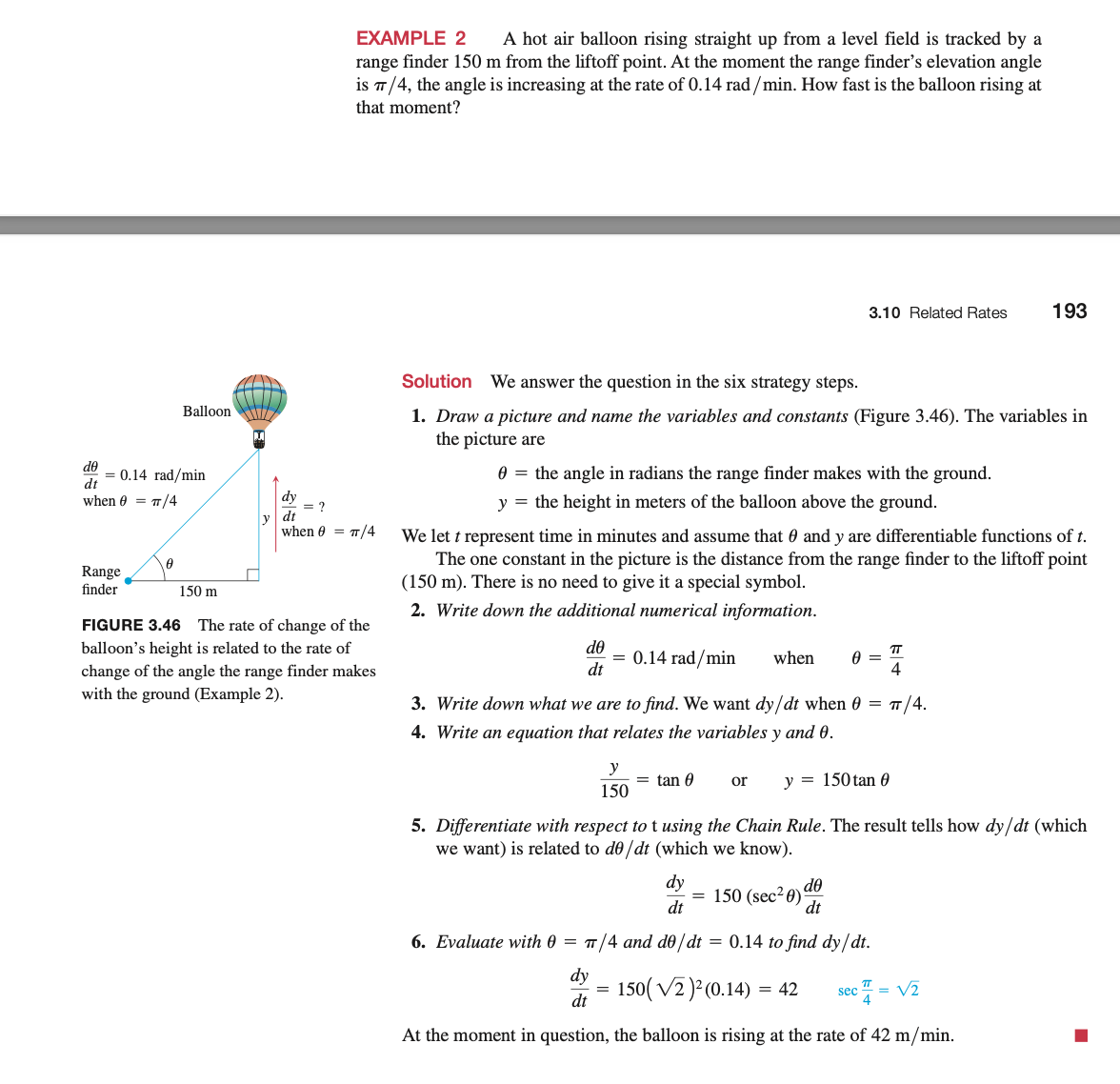How fast is the distance between the range finder and the balloon increasing (in meters per minute), when the range finder's elevation angle is 4 radians ? Enter a numerical answer, rounded to two decimal places.
How fast is the distance between the range finder and the balloon increasing (in meters per minute), when the range finder's elevation angle is 4 radians ? Enter a numerical answer, rounded to two decimal places.
Mathematics For Machine Technology
8th Edition
ISBN:9781337798310
Author:Peterson, John.
Publisher:Peterson, John.
Chapter20: Ratio And Propor Tion
Section: Chapter Questions
Problem 20A: In Figure 208, gear A is turning at 120 revolutions per minute and gear B is turning at 3.6...
Related questions
Question

Transcribed Image Text:Carefully read Example 2 on pages 192-193, and answer the following related question:
How fast is the distance between the range fınder and the balloon increasing (in meters per minute), when the range finder's elevation angle is
radians ?
Enter a numerical answer, rounded to two decimal places.

Transcribed Image Text:A hot air balloon rising straight up from a level field is tracked by a
range finder 150 m from the liftoff point. At the moment the range finder's elevation angle
is T/4, the angle is increasing at the rate of 0.14 rad /min. How fast is the balloon rising at
EXAMPLE 2
that moment?
3.10 Related Rates
193
Solution We answer the question in the six strategy steps.
Balloon
1. Draw a picture and name the variables and constants (Figure 3.46). The variables in
the picture are
de
= 0.14 rad/min
0 = the angle in radians the range finder makes with the ground.
dt
dy
= ?
dt
when e = T/4
y = the height in meters of the balloon above the ground.
when e = 7/4
We let t represent time in minutes and assume that 0 and y are differentiable functions of t.
The one constant in the picture is the distance from the range finder to the liftoff point
(150 m). There is no need to give it a special symbol.
Range
finder
150 m
2. Write down the additional numerical information.
FIGURE 3.46 The rate of change of the
balloon's height is related to the rate of
do
TT
= 0.14 rad/min
dt
when
4
change of the angle the range finder makes
with the ground (Example 2).
3. Write down what we are to find. We want dy/dt when 0 = T/4.
4. Write an equation that relates the variables y and 0.
y
= tan 0
y = 150 tan 0
or
150
5. Differentiate with respect to t using the Chain Rule. The result tells how dy/dt (which
we want) is related to de /dt (which we know).
dy
= 150 (sec? 0)
dt
do
dt
6. Evaluate with 0 = /4 and d0/dt
= 0.14 to find dy/dt.
dy
150( V2) (0.14)
= 42
sec
dt
At the moment in question, the balloon is rising at the rate of 42 m/min.
Expert Solution
This question has been solved!
Explore an expertly crafted, step-by-step solution for a thorough understanding of key concepts.
This is a popular solution!
Trending now
This is a popular solution!
Step by step
Solved in 3 steps with 3 images

Recommended textbooks for you

Mathematics For Machine Technology
Advanced Math
ISBN:
9781337798310
Author:
Peterson, John.
Publisher:
Cengage Learning,

Elementary Geometry for College Students
Geometry
ISBN:
9781285195698
Author:
Daniel C. Alexander, Geralyn M. Koeberlein
Publisher:
Cengage Learning

Elementary Geometry For College Students, 7e
Geometry
ISBN:
9781337614085
Author:
Alexander, Daniel C.; Koeberlein, Geralyn M.
Publisher:
Cengage,

Mathematics For Machine Technology
Advanced Math
ISBN:
9781337798310
Author:
Peterson, John.
Publisher:
Cengage Learning,

Elementary Geometry for College Students
Geometry
ISBN:
9781285195698
Author:
Daniel C. Alexander, Geralyn M. Koeberlein
Publisher:
Cengage Learning

Elementary Geometry For College Students, 7e
Geometry
ISBN:
9781337614085
Author:
Alexander, Daniel C.; Koeberlein, Geralyn M.
Publisher:
Cengage,

Functions and Change: A Modeling Approach to Coll…
Algebra
ISBN:
9781337111348
Author:
Bruce Crauder, Benny Evans, Alan Noell
Publisher:
Cengage Learning


Algebra & Trigonometry with Analytic Geometry
Algebra
ISBN:
9781133382119
Author:
Swokowski
Publisher:
Cengage